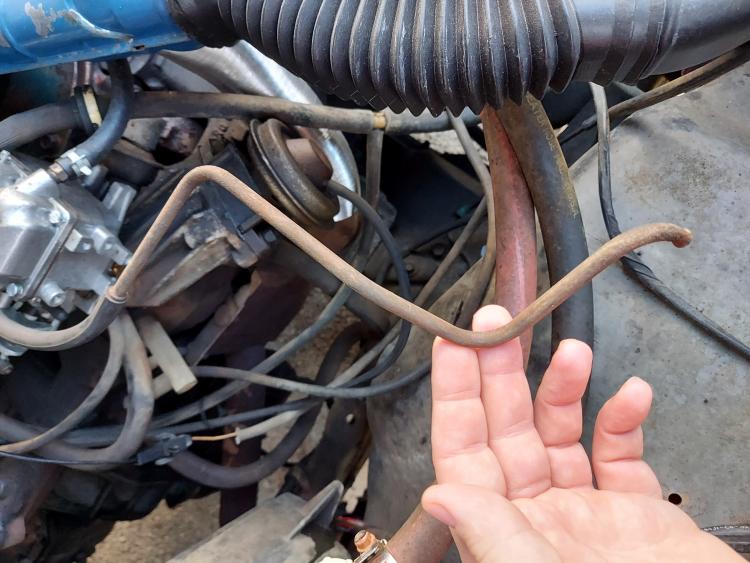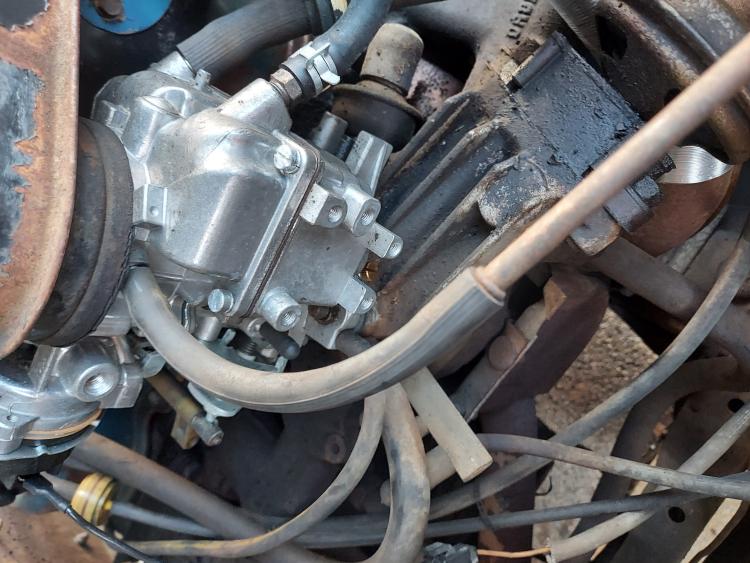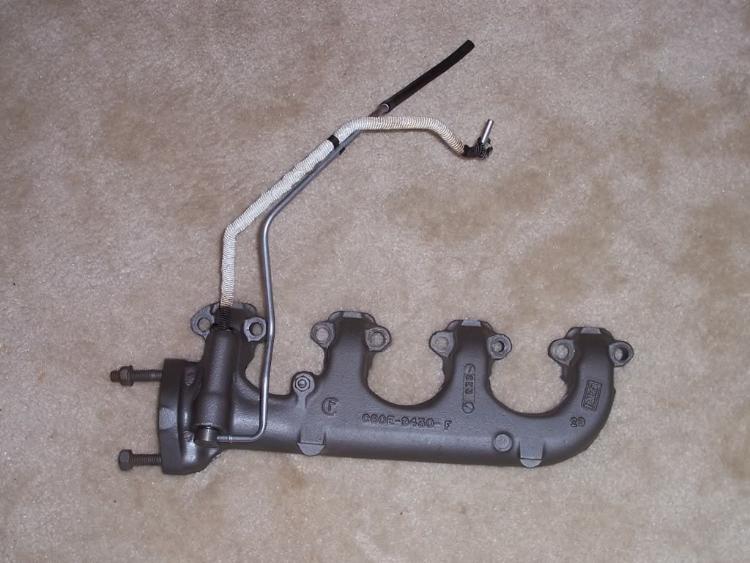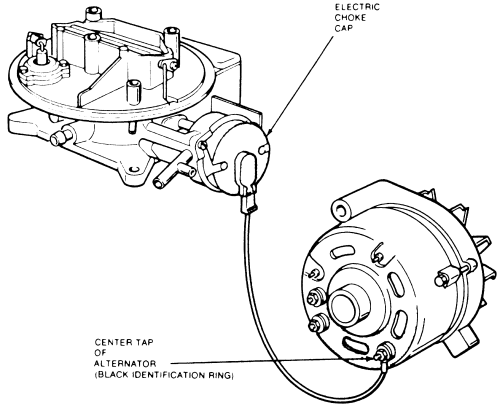Search Forum
Mystery hose?
  I need help identifying a mystery hose attached to my carborator. You can see where it comes from and then changes over to metal with a flange at the end. Question 1: What is it and what does it do? Question 2: Where does it go from the carborator? When I got the truck it was never hooked up anywhere and I can't find where it should connect.
1980 F100 Custom. Inline 6. Power steering. 3 on the Column.
|
|
well, it hooks to the upper portion of the carburetor and that means it is atmospheric pressure, not vacuum and that means it is a way for another item to get "filtered air". what type of choke did the engine come with? its most likely the incoming air to the choke stove before being drawn into the choke at the carburetor. the choke stove was mounted at/on/around the exhaust manifold and most of those by now have rusted away. i do have one of these on a pallet in the shop that is not rusted away and is mostly complete. i will try to remember to look it over Monday and see for sure.
|
|
The choke is one pump of the accelerator before cranking. It has run this long without being hooked up. Is it needed? Will anything run better if it is hooked up?
1980 F100 Custom. Inline 6. Power steering. 3 on the Column.
|
|
right now, i would set it aside and put a vinyl cap on the port.it is not letting much but it is letting unfiltered air into the air filter. you describe how you set the choke not exactly what type mechanically it has. basic choke would draw warmed air in through a bi metal coil spring which winds/unwinds slightly as a reaction to the temp. when cold it holds the choke closed (after one pump of the pedal) then begins to open the choke as the coil spring gets heated, up to the point where you start to us the throttle and release the choke mechanism. all of this was engineered into /onto the carburetor to be as user friendly as possible. requiring only a pump of the pedal at startup from the driver. modern cars took that step out also. that's why we old guys now call carburetors "anti-theft devices"

|
|
In reply to this post by Powerman5K
This is part of the thermostatic choke system. The choke systems on these trucks are Electrically assisted thermostatic systems and need both parts working to "work" properly.
This tube supplies clean air from the air cleaner to the choke stove which is in the original equipment exhaust manifold. This metal tube hooks to the bottom of the exhaust manifold itself in the location just behind and to the side of the carburetor. It looks busted off in the picture. The air goes through the choke stove, is heated up, and is delivered to the carburetor choke cap spring using another tube that comes out of the top of the exhaust manifold, and attaches to the carb using a compression fitting. Without this hooked up; the choke will not be able to be adjusted properly, and will open either too soon or too late depending on how the electric part is adjusted to compensate. Another symptom that could happen by not having it hooked up is Carburetor Icing. The carburetor can actually freeze in cold temps causing all kinds of drivability issues. So it would be best to get it hooked up and working. Hope this helps,
Truck: 1981 F-150 Explorer / Engine: 300-6 California MCU Feedback System / Trans: T-18 - 4 speed / 2.75 Ford Rear Axle Open Diff.
|
|
Thanks for the info. Anyone have a diagram or a picture showing where this hooks up to the manifold?
1980 F100 Custom. Inline 6. Power steering. 3 on the Column.
|
|
This is the diagram and it shows the tube #9820 that has broke off. Six cylinder engine.
https://www.garysgaragemahal.com/chokes.html I tried looking up the part number for you but it was discontinued as far back as 1994, and says to improvise using bulk tubing. My older book from 1986 states part number E0TZ-9820-A. No one has it anywhere.
Truck: 1981 F-150 Explorer / Engine: 300-6 California MCU Feedback System / Trans: T-18 - 4 speed / 2.75 Ford Rear Axle Open Diff.
|
|
im at the point of dealing with the same issue on the truck im resurrecting this week. the hot air tube from the intake to the choke is rusted off. i need to remove the intake plate beside the carb and tap it for a thread that i can fit a fitting to to replace the riser. right now it is just using the electric element but the cold air coming in slows the release.
|
|
I'm in the same boat. My truck is running rough when I first start it in the winter. It shuts down every time I stop at a stop sign for the first 10 minutes of driving. Makes getting out of my neighborhood a little dicy at times! Do you think fixing this will help that?
1980 F100 Custom. Inline 6. Power steering. 3 on the Column.
|
|
In reply to this post by 81-F150-Explorer
I replaced mine with 1/4" copper ice maker tubing. Had to remove the manifolds though, which I tackled while the engine was out for a rebuild. Drilled the tube remains, and attempted to solder the tubes in place (didn't wet in... but at least filled the gaps a bit).
I will say that the choke didn't work right until I had such fixed... the electric part alone doesn't fully compensate.
1984 F150: 300 L6, AOD, RWD. EEC IV / TFI, Feedback Carter YFA Carb. Stock everything but radio (for now).
|
|
In reply to this post by Powerman5K
Yes, it will absolutely help! In fact, it should eliminate the problem completely. When you get the air tubes hooked up and the choke adjusted correctly, there should be very little difference between driving a carbureted vehicle in the winter compared to a modern fuel injected vehicle. (Yes, I am serious.) Wouldn't that be nice? Here is a diagram you asked for. This is for a V8 engine, but the setup is basically the same. Thermostatic choke tubes:  Electric assist choke cap: 
Lucille: 1985 Ford F150 XLT Lariat
*Colors: Dark Canyon Red exterior, Canyon Red interior *Engine: 5.0, CompCams 31-230-3, "Thumper" E7 heads, Edelbrock Performer intake, Autolite 4100 carburetor, DuraSpark II ignition, Thorley Tri-Y headers, Flowmaster dual exhaust, H-pipe. *Drivetrain: AOD transmission, 3.55 gears, 2wd. |
|
In reply to this post by Powerman5K
I have bought everything I need to replace this tube over the weekend. Has anyone ever done it without removing the manifold on a 4.9? I would rather not tear all of that out if it is not needed. I keep hearing horror stories about breaking off studs.
1980 F100 Custom. Inline 6. Power steering. 3 on the Column.
|
Bullnose Enthusiasts Forum
|
1 view|%1 views
| Edit this page |

